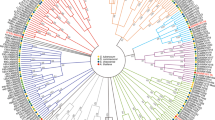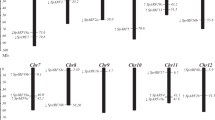Abstract
WD-repeat (WDR) proteins are highly abundant and participate in a seemingly wide range of interactions and cellular functions acting as scaffolding molecules. However, WDR identification in potato has not been conducted so far. In this study, we demonstrated the presence of at least 168 WDR genes in potato (Solanum tuberosum L.) which can be subdivided into five discrete clusters (Cluster I–V) and 10 classes inferred from their phylogenetic features of the constituent genes and the distribution of domains. These genes are distributed on all 12 chromosomes, of which chromosome 3 carries the most genes with 26 StWDRs. The expression of potato WDR genes showed tissue specificity with a high expression in carpels, callus and roots, and the expression patterns were obviously different among different genes. Transcript profiling of 168 StWDR genes revealed the particular tissues in which the 168 StWDR are expressed, and displayed a high expression in carpels, callus and roots. Most StWDRs were modulated by salt, ABA and Verticillium dahliae stresses, of which StWD092 was found to be highly expressed under all the three stresses. These outcomes revealed the intricate crosstalk between WDRs and other regulatory networks in the event of adverse milieu.








Similar content being viewed by others
References
Arshad M, Gruber M, Hannoufa A (2018) Transcriptome analysis of microRNA156 overexpression alfalfa roots under drought stress. Sci Rep 8:9363
Bian SM, Li XY, Mainali H, Chen L, Dhaubhadel S (2017) Genome-wide analysis of DWD proteins in soybean (Glycine max): significance of Gm08DWD and GmMYB176 interaction in isoflavonoid biosynthesis. Plos One 12:e0178947
Biedermann S, Hellmann H (2010) The DDB1a interacting proteins ATCSA-1 and DDB2 are critical factors for UV-B tolerance and genomic integrity in Arabidopsis thaliana. Plant J 62:404–415
Chen YN, Brandizzi F (2012) AtIRE1A/AtIRE1B and AGB1 independently control two essential unfolded protein response pathways in Arabidopsis. Plant J 69:266–277
Dai XB, Zhuang ZH, Zhao PXC (2018) psRNATarget: a plant small RNA target analysis server (2017 release). Nucleic Acids Res 46:W49–W54
Feng YS, Zhang C, Luo Q, Wei X, Jiang BM, Zhu HL, Zhang LL, Jiang L, Liu MD, Xiao XZ (2012) A novel WD-repeat protein, WDR26, inhibits apoptosis of cardiomyocytes induced by oxidative stress. Free Radical Res 46:777–784
Gong J, Cui Z, Li L, Ma Q, Wang Q, Gao Y, Sun H (2015) MicroRNA-25 promotes gastric cancer proliferation, invasion, and migration by directly targeting F-box and WD-40 Domain Protein 7, FBXW7. Tumour Biol 36:7831–7840
He SZ, Tong XL, Han MJ, Hu H, Dai FY (2018) Genome-wide identification and characterization of WD40 protein genes in the silkworm. Bombyx mori. Int J Mol Sci 19:527
Huang J, Wang MM, Bao YM, Sun SJ, Pan LJ, Zhang HS (2008) SRWD: a novel WD40 protein subfamily regulated by salt stress in rice (Oryza sativa L.). Gene 424:71–79
Im JS, Cho JH, Cho KS, Chang DC, Fin YI, Yu HS, Kim WY (2016) Effect of salinity stress on growth, yield, and proline accumulation of cultivated potatoes (Solanum tuberosum L.). Korean J Hortic Sci Technol 34:818–829
Jain BP, Pandey S (2018) WD40 repeat proteins: signalling scaffold with diverse functions. Protein J 37:391–406
Knapp S, Bohs L, Nee M, Spooner DM (2004) Solanaceae—a model for linking genomics with biodiversity. Comp Funct Genomics 5:285–291
Kong DJ, Li MJ, Dong ZH, Ji HT, Li X (2015) Identification of TaWD40D, a wheat WD40 repeat-containing protein that is associated with plant tolerance to abiotic stresses. Plant Cell Rep 34:395–410
Lee JH, Terzaghi W, Gusmaroli G, Charron JBF, Yoon HJ, Chen HD, He YJ, Xiong Y, Deng XW (2008) Characterization of Arabidopsis and rice DWD proteins and their roles as substrate receptors for CUL4-RING E3 ubiquitin ligases. Plant Cell 20:152–167
Li Q, Zhao PP, Li J, Zhang CJ, Wang LN, Ren ZH (2014) Genome-wide analysis of the WD-repeat protein family in cucumber and Arabidopsis. Mol Genet Genomics 289:103–124
Lin P, Zhu LJ, Sun WJ, Yang ZK, Sun H, Li D, Cui RJ, Zheng XL, Yu XG (2018) Prostate cancer cell proliferation is suppressed by microRNA-3160-5p via targeting of F-box and WD repeat domain containing 8. Oncol Lett 15:9436–9442
Liu WC, Li YH, Yuan HM, Zhang BL, Zhai S, Lu YT (2017) WD40-REPEAT 5a functions in drought stress tolerance by regulating nitric oxide accumulation in Arabidopsis. Plant Cell Environ 40:543–552
Matar KAO, Chen XF, Chen DJ, Anjago WM, Norvienyeku J, Lin YH, Chen ML, Wang ZH, Ebbole DJ, Lu GD (2017) WD40-repeat protein MoCreC is essential for carbon repression and is involved in conidiation, growth and pathogenicity of Magnaporthe oryzae. Curr Genet 63:685–696
Mishra AK, Puranik S, Prasad M (2012) Structure and regulatory networks of WD40 protein in plants. J Plant Biochem Biotechnol 21:S32–S39
Mishra AK, Muthamilarasan M, Khan Y, Parida SK, Prasad M (2014) Genome-wide investigation and expression analyses of WD40 protein family in the model plant foxtail millet (Setaria italica L.). Plos One 9:e86852
Neer EJ, Schmidt CJ, Nambudripad R, Smith TF (1994) The ancient regulatory-protein family of Wd-repeat proteins. Nature 371:812
Onder S, Caliskan ME, Onder D, Caliskan S (2005) Different irrigation methods and water stress effects on potato yield and yield components. Agric Water Manag 73:73–86
Rudack K, Seddig S, Sprenger H, Kohl K, Uptmoor R, Ordon F (2017) Drought stress-induced changes in starch yield and physiological traits in potato. J Agron Crop Sci 203:494–505
Salih H, Gong WF, Mkulama M, Du XM (2018) Genome-wide characterization, identification, and expression analysis of the WD40 protein family in cotton. Genome 61:539–547
Stief A, Altmann S, Hoffmann K, Pant BD, Scheible WR, Baurle I (2014) Arabidopsis miR156 regulates tolerance to recurring environmental stress through SPL transcription factors. Plant Cell 26:1792–1807
Stirnimann CU, Petsalaki E, Russell RB, Muller CW (2010) WD40 proteins propel cellular networks. Trends Biochem Sci 35:565–574
Tang RM, Zhu WJ, Song XY, Lin XZ, Cai JH, Wang M, Yang Q (2016) Genome-wide identification and function analyses of heat shock transcription factors in potato. Front Plant Sci 7:490
van Nocker S, Ludwig P (2003) The WD-repeat protein superfamily in Arabidopsis: conservation and divergence in structure and function. BMC Genomics 4:50
Villanueva MA, Islas-Flores T, Ullah H (2016) Editorial: signaling through WD-repeat proteins in plants. Front Plant Sci 7:1157
Wang RQ, Zhao P, Kong NN, Lu RZ, Pei Y, Huang CX, Ma HL, Chen Q (2018) Genome-wide identification and characterization of the potato bHLH transcription factor family. Genes 9:54
Wei CH, Kuang HH, Li F, Chen JJ (2014) The I2 resistance gene homologues in Solanum have complex evolutionary patterns and are targeted by miRNAs. BMC Genomics 15:743
Wu XZ, Wang KP, Song HJ, Xia JH, Jiang Y, Wang YL (2015) MiR-27a-3p promotes esophageal cancer cell proliferation via F-box and WD repeat domain-containing 7 (FBXW7) suppression. Int J Clin Exp Med 8:15556–15562
Yang LM, Liu HQ, Zhao JY, Pan YP, Cheng SY, Lietzow CD, Wen CL, Zhang XL, Weng YQ (2018) LITTLELEAF (LL) encodes a WD40 repeat domain-containing protein associated with organ size variation in cucumber. Plant J 95:834–847
Zeng CJT, Lee YRJ, Liu B (2009) The WD40 repeat protein NEDD1 functions in microtubule organization during cell division in Arabidopsis thaliana. Plant Cell 21:1129–1140
Zhang C, Wang DD, Yang CH, Kong N, Shi Z, Zhao P, Nan YY, Nie TK, Wang RQ, Ma HL, Chen Q (2017) Genome-wide identification of the potato WRKY transcription factor family. Plos One 12:e0181573
Zhang DP, Wang YZ, Shen JY, Yin JF, Li DH, Gao Y, Xu WF, Liang JS (2018) OsRACK1A, encodes a circadian clock-regulated WD40 protein, negatively affect salt tolerance in rice. Rice 11:45
Zou XD, Hu XJ, Ma J, Li T, Ye ZQ, Wu YD (2016) Genome-wide analysis of WD40 protein family in human. Sci Rep 6:39262
Acknowledgements
This study was supported financially by grants from the Natural Science Foundation of Jiangsu Province (BK20180519) and A Project Funded by the Priority Academic Program Development of Jiangsu Higher Education Institutions: Modern horticultural science (PAPD).
Author information
Authors and Affiliations
Corresponding author
Ethics declarations
Conflict of interest
On behalf of all authors, the corresponding author states that there is no conflict of interest.
Electronic supplementary material
Below is the link to the electronic supplementary material.
Rights and permissions
About this article
Cite this article
Tao, N., Zhu, W., Gan, M. et al. Genome-wide identification and functional analysis of the WDR protein family in potato. 3 Biotech 9, 432 (2019). https://doi.org/10.1007/s13205-019-1965-4
Received:
Accepted:
Published:
DOI: https://doi.org/10.1007/s13205-019-1965-4




